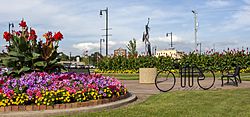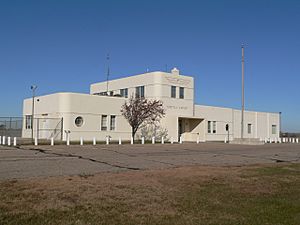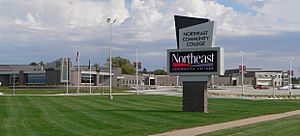Norfolk, Nebraska facts for kids
Quick facts for kids
Norfolk, Nebraska
|
|
|---|---|
 |
|

Location of Norfolk within Madison County and Nebraska
|
|
| Country | United States |
| State | Nebraska |
| County | Madison |
| Founded | 1866 |
| Area | |
| • Total | 11.68 sq mi (30.25 km2) |
| • Land | 11.35 sq mi (29.41 km2) |
| • Water | 0.32 sq mi (0.84 km2) |
| Elevation | 1,522 ft (464 m) |
| Population
(2010)
|
|
| • Total | 24,210 |
| • Estimate
(2019)
|
24,449 |
| • Density | 2,153.34/sq mi (831.40/km2) |
| Time zone | UTC-6 (CST) |
| • Summer (DST) | UTC-5 (CDT) |
| ZIP codes |
68701-68702
|
| Area code(s) | 402 |
| FIPS code | 31-34615 |
| GNIS feature ID | 0834976 |
| Website | http://www.ci.norfolk.ne.us/ |
Norfolk is a city in Madison County, Nebraska, United States, 113 miles northwest of Omaha and 83 miles west of Sioux City at the intersection of U.S. Routes 81 and 275. The population was 24,210 at the 2010 census, making it the ninth-largest city in Nebraska. It is the principal city of the Norfolk Micropolitan Statistical Area.
Contents
History
Settlement and early history
In late 1865 three scouts were sent from a German Lutheran settlement near Ixonia, Wisconsin, to find productive, inexpensive farmland that could be claimed under the Homestead Act. From the Omaha area they followed the Elkhorn River upstream to West Point. Finding that area too crowded, they continued up the river. On September 15, they reached the junction of the Elkhorn and its North Fork, and chose that area as a settlement site. On May 23, 1866, a party of 124 settlers representing 42 families from the Ixonia area set out for northeast Nebraska in three wagon trains. They arrived at the new site on July 15. A second group of settlers from Wisconsin arrived in July 1867.
The original name of the colony was a variant of "North Fork", but accounts differ on the exact name: "Northfork", "Nor'fork", and "Nordfork" are all suggested. The name was submitted to federal postal authorities, and at some point was transmuted to "Norfolk". The pronunciation "Norfork" is still used by many Nebraskans.
The North Fork settlement was named the county seat in 1867. In 1875 a series of elections changed this. In the first of these Norfolk, which at the time had 45 voters, was eliminated. In a subsequent election Madison was chosen over Battle Creek.
Railroads and growth
The Fremont, Elkhorn and Missouri Valley Railroad was built after the discovery of gold in the Black Hills in South Dakota. It ran from the Omaha area up the Elkhorn valley, then across northern Nebraska and into South Dakota. Its arrival at Norfolk in 1879 connected the city through Wisner to Blair on the Missouri. The Omaha, Niobrara, and Black Hills branch of the Union Pacific ran north from the railroad's main line at Duncan to Norfolk; it reached the city in 1880. The Chicago, St. Paul, Minneapolis & Omaha Railroad was completed to Norfolk in 1882.
The development of these railway connections led to significant growth in the city. In 1886 Norfolk's population reached 1000, making it a city of the second class. A street railway system and a public water supply were established in 1887. In 1888 a franchise was granted to the Norfolk Electric Light Company, and the Nebraska Telephone Company was given a right-of-way for "general telegraph and telephone business".
The Nebraska legislature created the Insane Asylum in Norfolk in 1885; it accepted its first patients in 1888. In 1920, the institution's name was changed to the Norfolk State Hospital; in 1962, it became the Norfolk Regional Center. As of 2010, it was a 120-bed institution.
Automobile age
In 1900, the city had a population of 3,883, nearly quadruple its population of a decade earlier. By 1910, it had more than 6,000 people, comprising roughly one-third of Madison County's population of 19,101. In 1915, petitions were filed for an election to move the county seat from Madison to Norfolk. The measure, however, failed to secure the necessary number of votes.
In the 1910s, development began on the Meridian Highway as a direct north-south route across the United States; the route of the highway ran through Norfolk. The 1924 completion of the Meridian Bridge across the Missouri River at the Nebraska-South Dakota border made the highway a continuous year-round thoroughfare. In 1926, it was designated as U.S. Highway 81. A second federal highway, U.S. Highway 275, received its designation in 1939; it follows the Elkhorn valley upstream from Omaha through Norfolk to O'Neill. During World War II, the segment from Norfolk to O'Neill was a portion of the Strategic Network of Highways; as such, it was given a high priority for federal funds for materials and for federal maintenance funds.
Air travel developed in Norfolk beginning with the establishment of a flying school in 1928. The school's field gradually expanded and was improved. In 1942 the WPA began construction of a municipal airport at the site. Although construction materials were limited during World War II, Norfolk received priority as an auxiliary field to several war-related airports, including Sioux City Air Field. After the war Norfolk congressman, Karl Stefan, a member of the Congressional Air Policy Board, used his influence to secure further funding for the airport. Commercial passenger flight through the airport began in the early 1950s.
In the 1970s, another attempt was made to move the county seat from Madison to Norfolk. In a 1975 county-wide election, the move's proponents failed to secure a simple majority. A 60% majority would have been necessary for the measure to pass.
On September 26, 2002, three gunmen robbed a US Bank branch in Norfolk, killing five people in the process. This was the nation's deadliest bank robbery in at least a decade.
Geography
Norfolk is located at 42°1′42″N 97°26′01″W / 42.02833°N 97.43361°W (42.0283379, -97.4169964).
According to the United States Census Bureau, the city has a total area of 10.78 square miles (27.92 km2), of which, 10.69 square miles (27.69 km2) is land and 0.09 square miles (0.23 km2) is water.
Climate
| Monthly Normal and Record High and Low Temperatures | ||||||||||||
| Month | Jan | Feb | Mar | Apr | May | Jun | Jul | Aug | Sep | Oct | Nov | Dec |
|---|---|---|---|---|---|---|---|---|---|---|---|---|
| Rec High °F | 74 | 76 | 88 | 95 | 103 | 106 | 113 | 107 | 101 | 95 | 83 | 71 |
| Norm High °F | 31.2 | 37.3 | 48.5 | 61.3 | 72.3 | 82.3 | 86.5 | 84.4 | 76.4 | 64 | 45.5 | 33.6 |
| Norm Low °F | 9.6 | 15.5 | 25.4 | 36.8 | 48.3 | 58 | 63 | 61 | 50.4 | 38 | 24.7 | 13.7 |
| Rec Low °F | -27 | -26 | -20 | 2 | 24 | 38 | 42 | 40 | 26 | 11 | -15 | -30 |
| Precip (in) | 0.57 | 0.76 | 1.97 | 2.59 | 3.92 | 4.25 | 3.74 | 2.8 | 2.25 | 1.72 | 1.44 | 0.65 |
| Source: USTravelWeather.com [1] | ||||||||||||
Demographics
| Historical population | |||
|---|---|---|---|
| Census | Pop. | %± | |
| 1880 | 547 | — | |
| 1890 | 3,038 | 455.4% | |
| 1900 | 3,883 | 27.8% | |
| 1910 | 6,025 | 55.2% | |
| 1920 | 8,634 | 43.3% | |
| 1930 | 10,717 | 24.1% | |
| 1940 | 10,490 | −2.1% | |
| 1950 | 11,335 | 8.1% | |
| 1960 | 13,111 | 15.7% | |
| 1970 | 16,607 | 26.7% | |
| 1980 | 19,449 | 17.1% | |
| 1990 | 21,476 | 10.4% | |
| 2000 | 23,516 | 9.5% | |
| 2010 | 24,210 | 3.0% | |
| 2019 (est.) | 24,449 | 1.0% | |
| U.S. Decennial Census 2018 Estimate |
|||
2010 census
As of the census of 2010, there were 24,210 people, 9,910 households, and 6,005 families living in the city. The population density was 2,264.7 inhabitants per square mile (874.4/km2). There were 10,625 housing units at an average density of 993.9 per square mile (383.7/km2). The racial makeup of the city was 88.0% White, 1.6% African American, 1.4% Native American, 0.6% Asian, 6.3% from other races, and 2.0% from two or more races. Hispanic or Latino of any race were 12.1% of the population.
There were 9,910 households, of which 31.0% had children under the age of 18 living with them, 46.3% were married couples living together, 10.6% had a female householder with no husband present, 3.7% had a male householder with no wife present, and 39.4% were non-families. 32.5% of all households were made up of individuals, and 11.3% had someone living alone who was 65 years of age or older. The average household size was 2.36 and the average family size was 3.00.
The median age in the city was 35.5 years. 24.5% of residents were under the age of 18; 12.1% were between the ages of 18 and 24; 23.6% were from 25 to 44; 25.1% were from 45 to 64; and 14.6% were 65 years of age or older. The gender makeup of the city was 49.0% male and 51.0% female.
Economy
Norfolk is the principal retail center of northeastern Nebraska. Other significant elements of the local economy include agriculture, manufacturing, and services including education and health care.
Major local manufacturers include Nucor, which employs about 1200 people manufacturing steel products at four locations in Norfolk; Covidien, with about 440 employees producing syringes and other medical supplies; Continental, employing about 350 producing high-pressure and hydraulic hose; Norfolk Iron & Metal, with 320 employees manufacturing steel products; and Wis-Pak, employing about 100 to produce soft drinks and other beverages.
Major non-manufacturing commercial employers include Wal-Mart, with about 410 employees, and Associated Wholesale Grocers, formerly known as Affiliated Foods Midwest, whose distribution center in Norfolk employs about 650. Other major employers include Faith Regional Health Services, a nonprofit with about 1,300 employees, and Norfolk Public Schools, with about 700.
Education
Norfolk has a single post-secondary educational institution, Northeast Community College, with over 7,000 students taking courses for credit. Over 18,000 students took non-credit courses; another 1,200 were in adult-education courses, including GED preparation, English as a second language, and preparation for the Naturalization test.
The Norfolk Public School District has an enrollment of over 4,000 students. There are seven elementary schools, six in Norfolk and one in the Woodland Park community; one preschool; one junior high school; and two high schools, Norfolk Senior High School and Alternatives For Success, the latter described as an "alternative high school". These schools lie between the Norfolk and Woodland Park communities.
There are several private elementary and high schools in the city. Norfolk Catholic Schools operates a grade school and Norfolk Catholic High School, with a total enrollment of about 650. Two Lutheran elementary schools and a high school enroll a total of about 470 pupils. St. Paul's Lutheran School is a Pre-K-8 school of the Wisconsin Evangelical Lutheran Synod (WELS) in Norfolk. Keystone Christian Academy enrolled about 60 students in pre-school through twelfth grade until its closure in May 2019.
Notable people
- Joyce Ballantyne, painter of pin-up art, was born in Norfolk.
- Jim Buchanan, a major-league baseball pitcher for the St. Louis Browns
- Max Carl (Gronenthal), singer and songwriter for .38 Special, grew up in Humphrey, and graduated from a Norfolk High School. He was with the band for its Rock & Roll Strategy and Bone Against Steel albums, and co-wrote the #1 hit song "Second Chance".
- Model rocketry was invented in Norfolk in 1954 by Orville Carlisle, working in the basement of his shoe store on 420 Norfolk Avenue.
- Television host Johnny Carson (born in Corning, Iowa) moved to Norfolk at the age of 8 and graduated from Norfolk High School.
- Jeromey Clary, an offensive tackle for the San Diego Chargers, was born in Norfolk.
- Joyce Hall, who created the Norfolk Post Card Company in 1908. The company eventually moved to Kansas City, Missouri, where it became Hallmark Cards.
- Philip N. Krasne, producer of the later Charlie Chan films and the Cisco Kid television series.
- Bill Lafleur, punter for San Francisco 49ers for two years. Graduated from Norfolk Catholic High School in 1994.
- Patrick M. Martin, later a U.S. Representative for California
- Scott Munter, pitcher for the San Francisco Giants, was born in Norfolk.
- Shane Osborn, pilot of the plane downed in the Hainan Island incident, and later Nebraska State Treasurer, was raised in Norfolk and graduated from Norfolk High School.
- Doris Pawn, an actress in silent motion pictures
- Thurl Ravenscroft, best known as the voice of "Tony the Tiger" and as the singer of the song "You're a Mean One, Mr. Grinch", was born in Norfolk.
- The Smoke Ring, a 1960s rock band.
- Don Stewart, actor best known for his role in Guiding Light
- Dean White, billionaire entrepreneur
See also
 In Spanish: Norfolk (Nebraska) para niños
In Spanish: Norfolk (Nebraska) para niños





